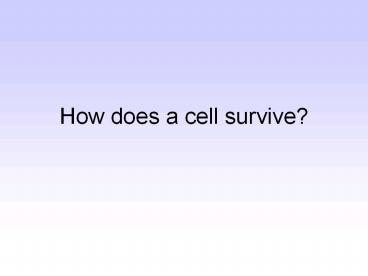How does a cell survive? PowerPoint PPT Presentation
1 / 20
Title: How does a cell survive?
1
How does a cell survive?
2
http//www.cs.brown.edu/stc/outrea/greenhouse/nurs
ery/biology/home.html
- Everything, from the structure covering the
cells to the organelles inside them, performs a
task that helps to keep the cell alive.
3
Cell Membrane
- Holds the cells inside organelles together
- Allows nutrients in and waste products out
4
PhospholipidsMolecules
- Make up the cell membrane and are made of fatty
acids and glycerol phosphates.
5
Cell Wall
- Only in plants and algae
- Made of cellulose
- Provides strength/support around the membrane
- It allows trees, leaves, plants to stand up.
6
Nucleus
- Means kernel or nut
- Is covered by a membrane which allows materials
to pass. - Is the control center of the cell
- Stores DNA (Which makes protein)
7
Nucleolus
- Dark spot inside the nucleus
- Stores material to make ribosomes.
Nucleus
DNA
Nucleolus
8
Ribosomes
- Are proteins (made of amino acids) which are the
building blocks of the cell. - Small organelles in every cell b/c they need
protein. - Have no membranes.
9
Endoplasmic Reticulum (ER)
- Covered with membrane
- Makes lipids
- Breaks down drugs/chemicals that might harm the
cell - Internal delivery system
- Moves through the tubular connections
10
Mitochondria
- The cells power plant
- Food molecules are broken down in the cell to
release energy. - Then, ATP moves energy to Mitochondria
- Bean shaped
- 2 membranes
- Work only with oxygen
Outer and Inner Membranes
11
Chloroplasts
- Only in plants and algae
- Energy-converting from the sun
- 2 membranes
- Looks like stacked coins
- Contain Chlorophyll (green) which traps light and
makes it into sugar (photosynthesis)
12
Chloroplasts Mitochondria
- Theory that they evolved from anceient bacteria.
- Created by cells eating each other.
- Have the same kind of ribosomes and circular DNA.
Old Bacteria
13
The Golgi Bodies
- From ER it transports modified lipids proteins
in its membrane. - Named after Camillo Golgi (Italian)
- Look like ER but are close to cell membrane
14
Vesicles
- Membrane covered compartments
- Formed from ER Golgi
- Ex. How white blood cells eat other cells.
Check out the picture on page 73 in your text
book.
15
Vacuoles
- Only in plants
- Membrane covered chamber
- Full of water
- Ex. Oranges
- Ever wonder how to make lettuce crisp or roses
red?
16
Lysosomes
- Only in animal cells
- Vesicles with enzymes.
- Destroy worn-out or damaged cells
- Get rid of waste
- Protect the cell.
- Ex. Caterpillars, tadpoles tales, aging
17
Plant Cell
18
Animal Cell
19
Plant Cell
20
So now, create a Venn diagram comparing a plant
and animal cell.

